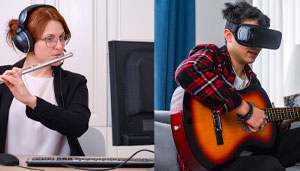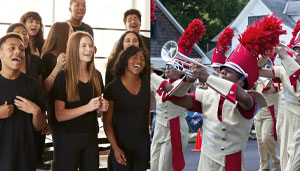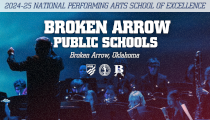Counting, Rhythm & Pulse in the String Class
By Terry Shade on October 25, 2022 music directors & adjudicators article PrintCounting aloud. Keeping a steady pulse. Correctly performing basic rhythm combinations. These are but a few of the necessities required in the string classroom each and every day! Easy, right?!? I’m afraid not. Do we find ourselves constantly urging students to stop rushing?
Do we feel the need to clap, snap, or “bang out” the beat on a music stand? Does the group make mistakes when reading basic rhythm combinations that have already been taught and supposedly reinforced? What about long, sustained notes? Do your students hold them for the full duration? Do the silences in the music get short-changed?
Let’s look inside our well-worn bag filled with teaching strategies and determine if the best tools are being implemented to teach counting, rhythm, and pulse. While bringing out a metronome can be incredibly helpful, it’s not the end-all solution toward getting the job done. It’s just one tool to assist in the many strategies and creative applications we need to have at the ready: useful techniques that are easy to implement for beginning, intermediate and advanced orchestra classes. Dedicate ample time toward the fundamentals of great rhythm and pulse. If you have first year beginners, lay the “foundation for your house” and you will not be sorry! If you have 2nd and 3rd year classes, make sure that foundation has remained rock solid so that more advanced rhythms and note values can be introduced smoothly, whether it’s part of your method book curriculum or in a new piece of performance music.
The following time-tested strategies and techniques, when used regularly, will benefit the orchestra from beginners on up.
Counting Aloud as a Group
String students (as compared to our woodwind and brass colleagues) have the built in “luxury” of counting aloud as they play. This is a huge advantage! From Day #1, work toward achieving group pulse and great rhythm using speak-aloud activities and drills. Train your students to count aloud, setting up a learning atmosphere in the room where they “speak the rhythm” and take it seriously. Because speaking aloud in this manner is typically awkward for ages 11-14, it’s going to take more than one reminder and lots of reinforcement to make sure that ALL students are participating. Let the class know when they are doing a great job. Praise individuals in class. Walk around the class, up and down the rows. Privately offer encouragement or corrections to those who might be unsure, quiet, or are having problems with counting aloud.
Try the following exercises. When setting up each exercise, double-check for fabulous posture throughout counting (two feet flat on the floor!).
- Have a simple and consistent counting system in place with all classes. “1 & 2 & 3 & 4 &” works beautifully for eighth notes and any eighth note combinations. Saying a strong “Rest!” for any and all rests is a very effective tool.
- Set a deliberately slower tempo for counting activities: “painfully” slow! This idea prevents the group from rushing later on, and ensures a successful transition from counting rhythm to performing rhythm on the instrument.
- Students may count aloud in unison (method book) as well as counting “parts” from their sheet music (by section, then all together).
- Write four bar rhythm lines on the board. Point to rhythms as students “say” them. Pitch and music staff are not needed here. If time permits, call on individuals to compose their own rhythmic combinations!
Note: Feel free to add a “toe tap” while these activities go on.
Regarding the counting of whole notes
If students are presented with a whole note when counting aloud, instruct them to say a long “one……” for the duration of 4 steady beats. Initially, students make the common mistake of saying “1-2-3-4” which is actually 4 quarter notes. Use the long “one…” for all notes with long durations.
For advanced classes
When we are teaching complex rhythm combinations from sheet music (e.g., parts including 16th notes, dotted figures or ties), saying the correct beat numbers and correct syllables may become time consuming and hard. After you have taught them the “math behind the music,” you can simplify the activity by having kids speak a portion of their piece (no pitch involved) on a single syllable “ta.” Don’t forget to say “rest” for rests!
Other fun and useful counting tools
- Students count aloud “down–2–up –4” while bowing half notes.
- Students speak “lift–and–set” when first learning lift bows.
- Students “count themselves off” before playing an exercise or a piece (“rest–rest– rest–rest!” or “rest–2–3–4” or a bar of 8th notes, or a bar of 16th notes, etc.).
- Require your young students to always count “one–two–three–four!” during whole note arco.
- Students pluck open D quarter notes (with bow in hand), while speaking eighth notes. This is the first step to subdivision!
- Divide the class into 3 groups of counters. One group counts half notes, the second group counts quarter notes, while the third counts eighth notes. Switch parts frequently for fluency.
Step by Step
When teaching a new rhythm, put in as many teaching steps as possible for days one and two. After that, you will want to drop a step or two and shorten your lesson a bit. Can you put in too many teaching steps? No way! Remember, though, that the strategies you incorporate into your class plan depends on how often your class meets each week. Obviously, if your class meets twice each week, you’ll likely handle the teaching steps and their reinforcement differently than a class that meets five times per week.
Below is a sequential example for teaching eighth notes/eighth note combinations on day one: Feel free to repeat steps as many times as necessary for proficiency.
Step 1: Discuss/explain the math behind eighth notes
Step 2: Rote counting “me say, you say!”
Step 3: Write a few simple lines of eighth note rhythms on the board, students count aloud (leave some space to write the counting underneath)
Step 4: Students play pizzicato rhythms on open D
Step 5: Students play “bow in the air” while counting aloud (vertical, not horizontal)
Step 6: Students bow the rhythm lines on open D
Step 7: Students add left fingers (tetrachord or scale)
Step 8: Students adapt steps again to correlate with method book lesson and corresponding sheet music
Subdivide Regularly
- For years, I thought subdivision was utilized mainly at the high school level. Not true! Teaching middle school students how to subdivide is a skill that will benefit the individual musician as well as the entire group! Below are some key points to think about, before introducing this technique to your classes:
- Choose music that is conducive to dividing notes into 8ths or 16ths. Small Overture by Bob Mathews (published by Kjos Music) is a great example of this.
- Teacher demonstrations are vital. Allow them to hear exactly how to turn a dotted quarter/eighth note rhythm into all eighths.
- Avoid any initial confusion observe the following rules for subdivision:
- ignore all slurs
- play in the middle of the bow
- begin down bow at the start of most measures
- play mechanically
- play smoothly
- use small amounts of bow
Your young, less experienced players are capable of subdividing whole notes and half notes into quarters or even eighths notes, when appropriate. The orchestra will enjoy this intellectual activity if you use an optimistic and enthusiastic approach.
Rehearse Repertoire Arco on the Open String
When your orchestra is learning a new piece, place each section in charge of playing various rhythm combinations independent of other sections. Rests are involved as well as sustained notes and faster notes (choose a piece with limited or no slurs). Now is a great time to take out the left hand notes, having the students bow the rhythm on an open D string. Take your time and hear each section before putting it together. Aim high, insisting on accuracy and uniform bowings from everyone. Overall rhythm and bow management skills will rapidly improve with the left hand notes out of the mix.
Rehearse Repertoire Pizzicato
With bows removed, great rhythmic information is revealed! Is the tempo steady or are your students rushing a bit? Are certain sections rushing? What happens when plucking a bunch of repeated notes in the part? Do the students count through sustained notes and ties? Do you hear mistakes and inaccuracies throughout the piece? Work diligently to improve whatever imperfections you may hear during this rehearsal time. Guide them and remind them to keep the pulse as steady as possible and to count constantly.
Other Tricks of the Trade to Consider
Below are additional activities geared toward heterogeneous drill style instruction. These pulse and rhythm techniques may be utilized during scales, warm-ups, or while rehearsing repertoire. They are loosely listed from basic to more complex: ahead, behind, or right on! One stand partner counts, the other one plays!!
- Switch off: Divide the group – cello/bass and violin/viola for activities and drills. Have cellos/basses be the “beat keepers” using pizzicato tonic pulse while the violin/violas play scales, and warm-ups. Switch. The beat keepers can use a quarter note or a half note pulse. This keeps all sections busy!
- One person plays, stand partner counts. Switch as necessary.
- One person subdivides, stand partner plays as written.
- Ahead, behind or RIGHT ON! Choose one student to play an excerpt with you. Ask the class, if said student was “ahead, behind, or right with you.”
- Teach the class to conduct.
- Purchase an app such as “Drum Beats” (found in iTunes) to play through your speakers or bluetooth speaker. This app uses many diverse styles of beat, making scales and warm-ups so much fun!
By reaching in and using the myriad tools found in your well-worn bag of teaching strategies, your goals can be achieved.I hope this article helped youfind some tools you hadn’t used for a while and also inspired you to add some new ones that will come into use soon.Just wait! Students will perform as their own metronomes, allowing us to step back and lovingly watch them play without the assistance of pulse-keeping. With pulse, counting, and rhythmic issues solidified, the playing, the expressive music making we strive for will unfold. What a fantastic outcome!
Terry Shade
This article first appeared in WMEA’s Voice Magazine, October 2019 edition. WMEA supports music educators in an effort to ensure that every student in Washington State has access to a comprehensive, sequential music education taught by highly qualified and certified teachers. Check out the Washington Music Educators Association here: (https://wmea.org/)
Most Recent Articles







